25 August 2017
Pizzo Cengalo rock avalanche – Planet satellite imagery captured the landslide in motion
Posted by Dave Petley
Pizzo Cengalo rock avalanche – Planet satellite imagery captured the landslide in motion
The Pizzo Cengalo rock avalanche in Switzerland on Wednesday has attracted considerable attention, not least because of the two amazing videos that were captured of the event. The first caught the initiation of the collapse and the initial development of the avalanche itself:-
.
And second the extraordinarily destructive nature of the flow some 5 km downstream:-
.
This is of course far from the first event on this mountain, although with eight people recorded missing it may be the most tragic. Given that it is well-studied I will allow others to write in detail about it, but would point out one fascinating aspect of the first video. This is an apparent shock wave (?) that appears to travel ahead of the main dust cloud immediately after the mass strikes the valley floor. I have tried to capture it in this screenshot:-
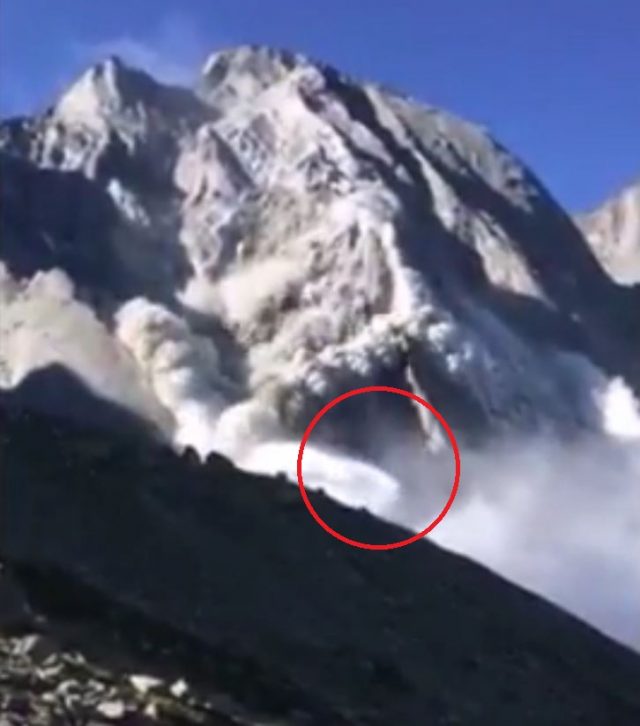
Possible shock wave from the Pizzo Cengalo rock avalanche? Via Youtube
.
I am no expert in these events, but given the speed with which this moves downslope I am hypothesising that this might be a shock wave? Can anyone else comment?
Perhaps even more interesting than that is a set of images from Planet Labs. One of their constellation of satellites was overhead at the time, and remarkably has captured the landslide in motion. This is an image taken on 4th August of the site of the Pizzo Cengalo rock avalanche:-
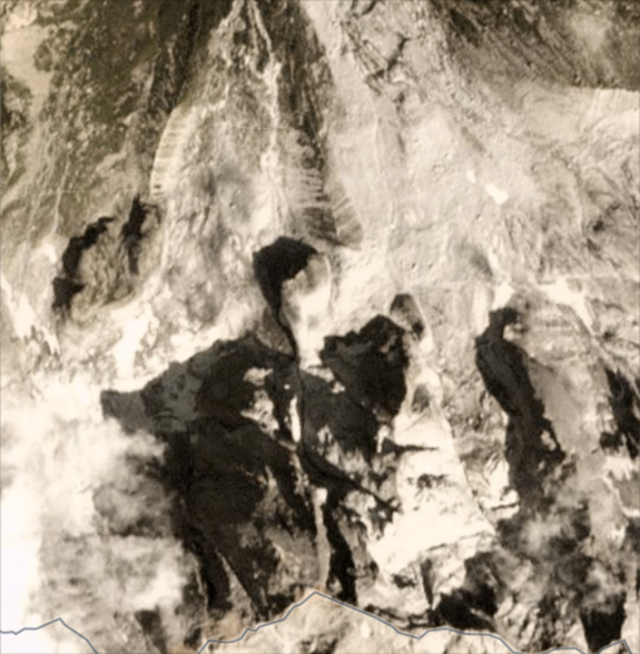
Planet Labs image of the site of the Pizzo Cengalo rock avalanche site, dated 4th August.
.
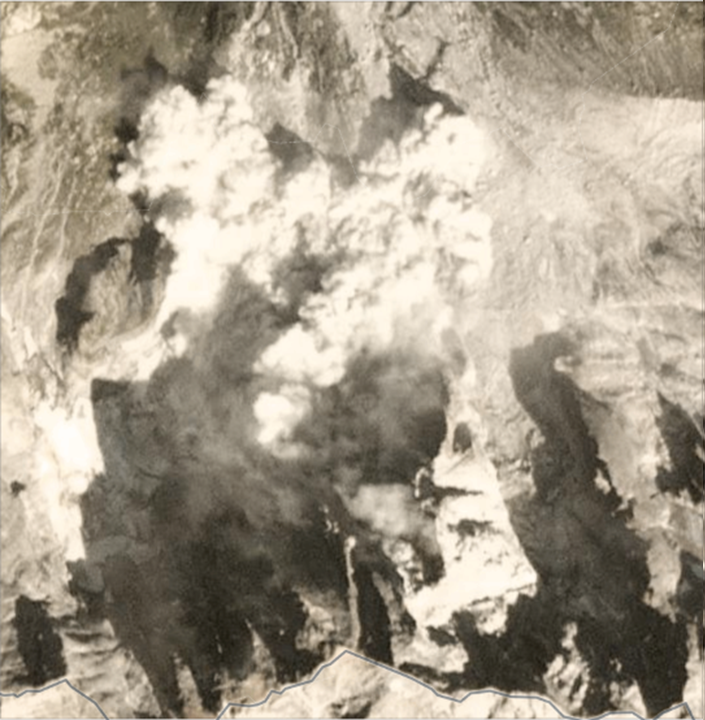
Planets Labs image of the Pizzo Cengalo rock avalanche in motion.
.
An even more fascinating aspect of this data is that the way in which the Planet Labs satellites collect imagery means that the near infrared (NIR) image is collected separately from the optical (RGB) imagery, with a 0.5 second gap between them. On this basis, Bas Altena from University of Oslo suggested that the movement might be visible in the imagery. The gap between these two images can be seen below – if you look carefully you can see that the dust clouds have moved in that 0.5 second period. This is the NIR image (which has a lower resolution):-
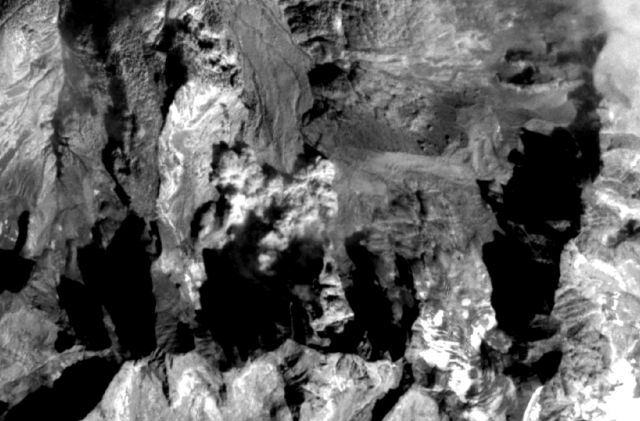
Planet Labs NIR image of the Pizzo Cengalo rock avalanche in motion.
.
And this, half a second later, is the Red band of the optical imagery:
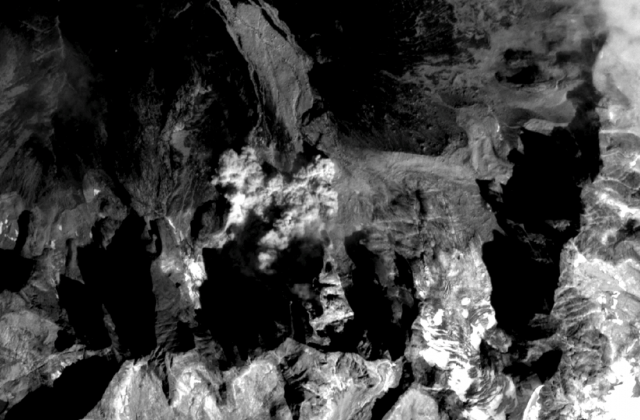
Planet Labs Red band image of the Pizzo Cengalo rock avalanche in motion
.
Acknowledgement
Planet Team (2017). Planet Application Program Interface: In Space for Life on Earth. San Francisco, CA. https://api.planet.com
Thanks in particular to Joe Mascaro of Planet Labs, who pointed out that this event had been captured, Bas Altena from University of Oslo who suggested the RGB/NIR trick, and to various friends who have tweeted, left comments and emailed me about this amazing event.


 Dave Petley is the Vice-Chancellor of the University of Hull in the United Kingdom. His blog provides commentary and analysis of landslide events occurring worldwide, including the landslides themselves, latest research, and conferences and meetings.
Dave Petley is the Vice-Chancellor of the University of Hull in the United Kingdom. His blog provides commentary and analysis of landslide events occurring worldwide, including the landslides themselves, latest research, and conferences and meetings.
Brilliant video.
My guess is that the “shock wave” is very fine dust (its very light in colour) emitted from a very fast-travelling and rapidly-fragmenting lobe of debris generated as the main rock mass hits the valley bottom.
Incidentally, where did all the water come from to generate the debris flow…Ice & snow in the runout path?
[Interesting – the velocity is extremely high. Is this possible for dust? In that case it would be a blast wave in effect? D.]
Indeed, there has most likely still been a significant amount of ice on the foot of the north face of Pizzo Cengalo, despite the earlier events. The official Swiss topographic map indicates a glacier as well as rock glaciers in the impact zone of the rock avalanche:
https://map.geo.admin.ch/?lang=en&topic=ech&bgLayer=ch.swisstopo.pixelkarte-farbe&layers=ch.bav.haltestellen-oev,ch.swisstopo.swisstlm3d-wanderwege,ch.swisstopo.hangneigung-ueber_30,ch.swisstopo-karto.skitouren&layers_visibility=false,false,false,false&layers_opacity=1,1,0.4,0.8&X=130171.75&Y=766898.50&zoom=8
The white cloud that Dave points out might also be a result of the impact on the ice field. In a fall like this, an enormous amount of heat energy gets released. In this case, even people who were standing on the opposite side of the valley claimed to have felt a heat wave (despite this fall coming out of a relatively cool north face). So one possible interpretation might be that this is steam coming from the vaporized ice field.
As a sidenote, there was certainly no snow left.
Yes it could certainly be ice.
Hi Tim, hi Dave,
The video, in my mind, shows two effects: first the development of huge brows dust clouds (Tim’s grain explosion effect) and, second a blast-like development and extremely fast propagation of white dust (snow, fine ice particles or even steam). Together with the recent Saldin Peak disaster in Nepal (eye-witness: “The second slope failure, however, consisted of over 1 million m³ of solid rock that plunged 300m down to the Langmale glacier, creating a massive blast upon impact that hurled house size boulders and icebergs up to 1 km in all directions.”) this points to an explosion. For this we have postulated that the impact energy of such rock masses on ice is by far sufficient to create a steam explosion (Hanisch and Schulz 2012, Banff Int. Landslide Conf.). The enormous acceleration observed in the video and the abundant appearance of melting (and sublimation?) water could be explained by such an effect.
Let us see what the Swiss experts of Uni and ETH Zurich will find out.
Best regards
Jörg
Hi!
http://orf.at/stories/2404494/2404498/
In this article of an austrian news site is written:
“Alone the shockwave of the rock avalanche bent many trees.”
BR, max
Thanks for your work + blog.
Hi Guys,
I’m venturing a bit “off-piste” as this is outside my specific area of academic research, but I happened to be vacationing in this area when this event occurred. As a matter of fact, I was just up the road in Sigel-Maria (Silvaplana) and was scheduled to take the bus to Chiavenna thru Bondo at the time this occurred. Due to a recalcitrant father-in-law, we changed to later…thus, missing this event, or being stranded on the Italian side of the border.
Now, down to details…I’m a Ph.D. Geographer, specialising in multipolarimetric Imaging RADAR and LIDAR systems, as well as optical (multi, hyperspec etc. etc.). I’ve been staying in the region for several years; the in-laws for 30 years. So, some scientific observations and anectdotal observations here…
For the past 3 years, there has been extreme temperature variations both in the valleys and at the peak tops.
Last year, for example, morning temps were 5-9C in the valleys in the morning, whilst by afternoon, reaching 32-33C. This year, to continue, I noted (my geograher’s diary), that on the previous two mornings, the low for the night(s) had been -3, then 2, then 0 C, in the Silvaplana (1805m), meanwhile, the day time high were 28, 28, 32C. Anecdotal conversations with mountain guides, and parents-in-law, who regularly hike the peaks, was a) declining peak snow caps and b) extreme temp variations, couple with c) ground at higher level being “boggy” (not permanently frozen, or hard).
Speaking for the remote sensing side of the house as per the blog’s thoughts…I’ve run a sequence of hyper and infrared imagery (using LANDSAT, ESA Sentinel etc.) for the past decade to examine the heat signatures of the rock masses (mountains) and to document temp variation (for my interest, not any particular research) and early results show considerable variation. I should also note that this event took place only a few days after the Ischia island earthquake; I point this out that much has been mentioned that this Bondo event was equivalent to 3.0 + on the Richter scale. I personally felt no ground effects in Sigel Maria, nor could I find anyone in Maloja or Stampa (furthest one could reach after road closure) that felt any ground effects. Merely anectdotal observation. I do note that this gentleman was widely quoted and interviewed in Swiss press per the issue of permafrost melt/destab/landslides…My slightly educated surmisal is that temp variation (rock fracturing?) coupled with a plastic (e.g. moisture laden soils) might be a rationale? Anyway, passing along observations from a nearby interested observer;-) !